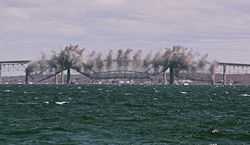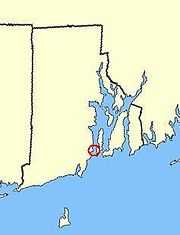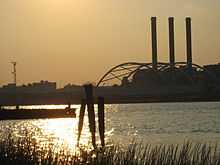Jamestown Bridge
Coordinates: 41°31′42.14″N 71°24′11.34″W / 41.5283722°N 71.4031500°W
| Jamestown Bridge Old Jamestown Bridge | |
|---|---|
 The Jamestown Bridge prior to demolition in April 2006 | |
| Official name | Jamestown-Verrazano Bridge |
| Carries |
2 lanes of |
| Crosses | West passage of Narragansett Bay |
| Locale | North Kingstown and Jamestown, Rhode Island |
| Maintained by |
Jamestown Bridge Commission (1940-1969) Rhode Island Department of Transportation (1969-1992) |
| Design | Cantilever truss |
| Total length | 6,892 ft (2,100 m) |
| Width | 22 ft (6.7 m) |
| Height | 135 ft (41.1 m) |
| Longest span | 600 ft (182.9 m) |
| Construction begin | January 1939 |
| Construction end | July 1940 |
| Opened | July 27, 1940 |
| Toll |
$0.25 (originally $0.90) (collected 1940-1969) |
| Closed | October 8, 1992 (demolished on April 18, 2006) |
The Jamestown Bridge, usually referred to as the Old Jamestown Bridge to avoid confusion with its replacement, the new Jamestown Verrazzano Bridge, was a cantilever truss bridge that connected Conanicut Island to mainland North Kingstown, Rhode Island, spanning the West passage of Narragansett Bay. The bridge first opened to traffic in 1940, replacing ferry service as the primary connection for the town of Jamestown, situated on Conanicut Island. It was constructed for just over $3 million 1940 USD, which was paid for by tolls until June 28, 1969. With a total length of 6,892 feet (2,100 m), the Jamestown Bridge was the third longest in Rhode Island at the time of its destruction, ranking behind its replacement, the adjacent 7,350-foot (2,240 m) Jamestown Verrazzano Bridge, and the 11,248-foot (3,428 m) Claiborne Pell Newport Bridge connecting Conanicut Island to Aquidneck Island and Newport. The Jamestown Bridge was closed to vehicular traffic on October 8, 1992, and its main span was destroyed through a controlled demolition on April 18, 2006.
Structure
The bridge consisted of 69 spans with a large continuous cantilever Warren truss centerpiece.[1] The 600 ft (183 m) main span was 135 ft (41 m) above the western portion of the Narragansett Bay. The bridge was long thought to be a danger to motorists, consisting of only two undivided lanes, which during the summer months, the eastbound lane was usually at a standstill due to vacationers traveling to Newport via the main route from the mainland. Its steep climb proved challenging for some vehicles and with no passing lanes or shoulders, hazardous conditions resulted when stalled vehicles were on the bridge. The roadway deck through the cantilevered span was an open steel-grid deck, similar to that of the Castleton Bridge just south of Albany, NY or the now demolished Sikorsky Bridge on the Merritt Parkway in Connecticut. On the main span looking down through the grates, you were able to see Narragansett Bay. The deck proved to be extremely slippery when wet. To solve the problems of the aging bridge, the RIDOT began construction of the new Jamestown-Verrazano Bridge in 1985. The new bridge, which opened with the Route 138 Freeway on October 8, 1992, includes four divided lanes of traffic with shoulders and a sidewalk.
Demolition


The United States Coast Guard had long declared the Jamestown Bridge to be a navigation hazard and requested that the state of Rhode Island dismantle the eastern two thirds of it. The Sierra Club, an environmental organization, suggested to instead turn the bridge into a bike route and walkway. However, the aging structure proved to be in far worse condition than previously thought, prompting officials to go ahead with removing the entire structure.
On April 18, 2006, the main span of the Jamestown Bridge was brought down by 75 pounds of RDX explosives and 350 shaped charges. TNT charges were later used to remove the concrete piers. On May 18, 2006, crews imploded the trusses that once carried the side spans. Throughout mid-2006, workers removed the remaining support piers and low-level approach spans west of the main channel. The extreme western portion of the bridge was not demolished with the remains of the bridge during 2006, as officials planned to renovate and convert it into a fishing pier, but ultimately it was removed in 2010 when renovation and cleanup proved too costly. That last part was then demolished in the same year. The total cost for removal of the Jamestown Bridge was US$22 million.
References
- ↑ "Jamestown-Verrazano Bridge: Historic Overview". BostonRoads.com. Eastern Roads. Retrieved 2008-02-09.
External links
| ||||||||||||||||
